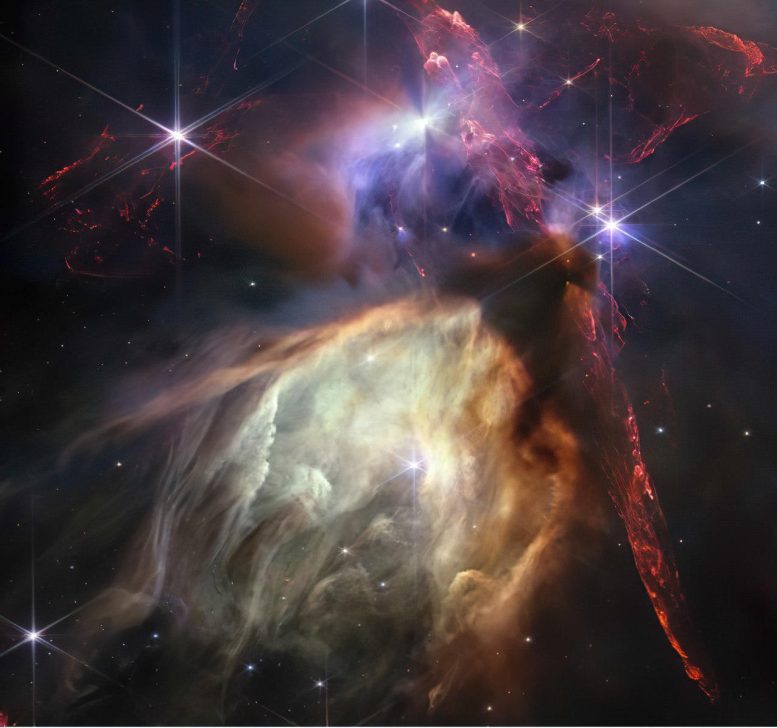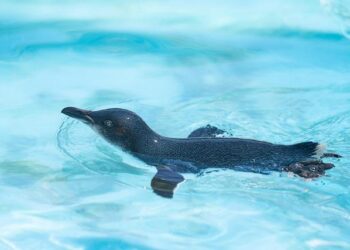
Image of the Rho Ophiuchi cloud complex, the closest star-forming region to Earth. This study reveals that the newly born stars in Rho Ophiuchi have not yet begun to drift apart and that the progenitor cloud is still holding them together. Credit: NASA, ESA, CSA, STScI, Klaus Pontoppidan (STScI)
A newly developed technique for estimating age reveals surprising findings about the formation and drifting apart of young stars.
A team of astrophysicists led by Núria Miret-Roig from the University of Vienna found that two methods for determining the age of stars measure different things: Isochronous measurement thereby determines the birth date of stars, while dynamical tracking provides information on when stars “leave their nest”, about 5.5 million years later in the star clusters studied.
The study, which makes it possible to determine the earliest stages of a star’s life, is currently published in the scientific journal Nature Astronomy.
The age of stars is a fundamental parameter in astrophysics, but it is still relatively difficult to measure. The best approximations to date have been for so-called star clusters, i.e. groups of stars of the same age with a common origin. The age of six relatively close and young star clusters has now been analyzed as part of a study at the Institute of Astrophysics at the University of Vienna.
It was found that two of the most reliable methods for determining the age of stars – isochronous measurement and dynamic tracing – were systematically and consistently different: The stars were each around 5.5 million years younger according to the dynamic tracing method than with the isochronous measurement.
When the clock starts ticking
“This indicates that the two measurement methods measure different things,” explains astrophysicist Núria Miret-Roig from the University of Vienna, first author of the study.
According to the new study, the isochronous “clock” starts ticking from the time of star formation, but the “clock” of dynamic backtracking only starts ticking when a star cluster begins to expand after leaving its parent cloud.
“This finding has significant implications for our understanding of star formation and stellar evolution, including planet formation and the formation of galaxies, and opens up a new perspective on the chronology of star formation. For example, the length of the so-called “embedded phase”, during which baby stars remain within the parental gas cloud, can be estimated,” explains João Alves, co-author and professor at the University of Vienna.
Measuring how long baby stars stay in the nest
“This age difference between the two methods represents a new and much-needed tool to quantify the earliest stages in a star’s life,” says Alves. “Specifically, we can use it to measure how long the baby stars take before they leave their nest.”
The measurements were made possible by the high-resolution data from the Gaia special mission in conjunction with ground-based radial velocities (e.g. from the APOGEE catalog). “This combination allows us to trace the positions of stars back to their birthplace with the accuracy of 3D velocities,” explains Miret-Roig.
New and upcoming spectroscopic surveys such as WEAVE, 4MOST, and SDSS-V will make this investigation possible for the entire solar neighborhood.
Puzzling difference
“Astronomers have been using isochronous ages for as long as we have known how stars work, but these ages depend on the particular stellar model we use,” says Miret-Roig. “The high-quality data from the Gaia satellite has now allowed us to measure ages dynamically, independently of the stellar models, and we were excited to synchronize the two clocks.” During the calculations, however, a consistent and puzzling difference between the two age determination methods emerged.
“And eventually we reached a point where we could no longer blame the discrepancy on observational errors – that’s when we realized that the two clocks were most likely measuring two different things,” says the astrophysicist.
For the study, the research team analyzed six nearby and young star clusters (up to 490 light years away and 50 million years old). The time scale of the embedded phase was found to be around 5.5 million years (plus/minus 1.1 million years) and could depend on the mass of the star cluster and the amount of stellar feedback.
Applying this new technique to other young and nearby star clusters promises new insights into the star formation process and the drifting apart of stars, Miret-Roig hopes: “Our work paves the way for future research into star formation and provides a clearer picture of how stars and star clusters evolve. This is an important step in our endeavor to understand the formation of the Milky Way and other galaxies.”
Reference: “Insights into star formation and dispersal from the synchronization of stellar clocks” by Núria Miret-Roig, João Alves, David Barrado, Andreas Burkert, Sebastian Ratzenböck and Ralf Konietzka, 23 November 2023, Nature Astronomy.
DOI: 10.1038/s41550-023-02132-4
This publication has been co-funded by the European Union (ERC, ISM-FLOW, 101055318, PI: J. Alves). However, the views and opinions expressed are solely those of the author(s) and do not necessarily reflect those of the European Union or the European Research Council. Neither the European Union nor the granting authority can be held responsible for them.
>>> Read full article>>>
Copyright for syndicated content belongs to the linked Source : SciTechDaily – https://scitechdaily.com/astrophysicists-crack-the-code-of-star-birth-and-aging/































